The Role of Training and Development in Enhancing Employee Performance
VerifiedAdded on 2020/01/06
|24
|2967
|67
Report
AI Summary
This report presents a comprehensive analysis of the impact of training and development programs on employee performance, using Morrison, a UK supermarket chain, as a case study. The study explores the background, significance, aims, objectives, and research questions related to the topic. It examines the factors influencing the selection of the topic and provides a critical review of relevant literature, including the views of Torraco (2016) and Mazerolle and Dodge (2015). The research employs both primary and secondary data collection methods with an inductive research design and an interpretivism approach. The report includes a Gantt chart to outline the study's timeline and presents findings from various themes related to training frequency, methods, employee satisfaction, and the impact on performance, motivation, and confidence. The analysis reveals that training and development programs significantly enhance employee performance, with Morrison utilizing both on-the-job and off-the-job training methods. The study concludes with recommendations for Morrison's management to conduct training and development programs regularly to adapt to the evolving retail industry and improve employee skills.

RESEARCH PROJECT
Paraphrase This Document
Need a fresh take? Get an instant paraphrase of this document with our AI Paraphraser
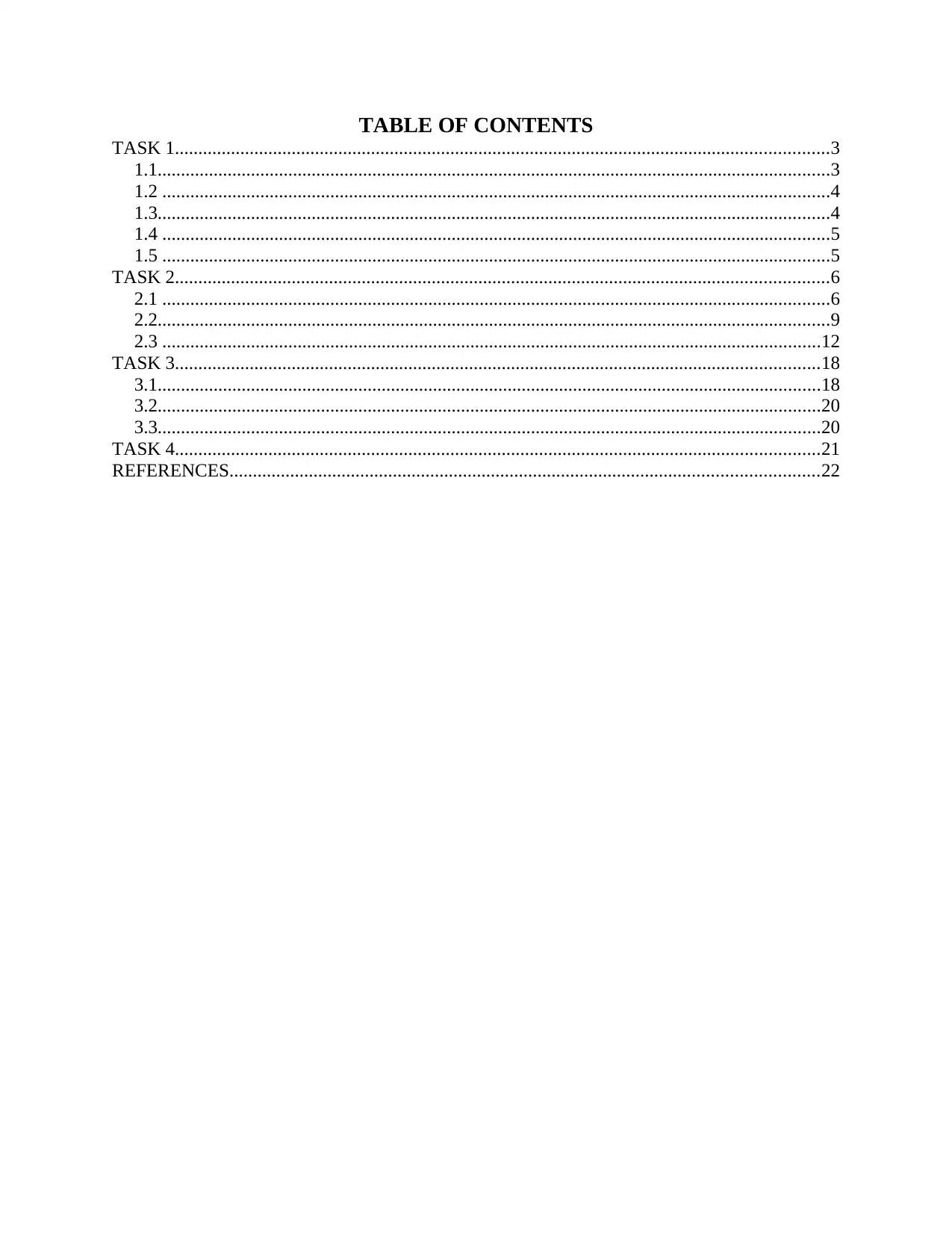
TABLE OF CONTENTS
TASK 1............................................................................................................................................3
1.1................................................................................................................................................3
1.2 ...............................................................................................................................................4
1.3................................................................................................................................................4
1.4 ...............................................................................................................................................5
1.5 ...............................................................................................................................................5
TASK 2............................................................................................................................................6
2.1 ...............................................................................................................................................6
2.2................................................................................................................................................9
2.3 .............................................................................................................................................12
TASK 3..........................................................................................................................................18
3.1..............................................................................................................................................18
3.2..............................................................................................................................................20
3.3..............................................................................................................................................20
TASK 4..........................................................................................................................................21
REFERENCES..............................................................................................................................22
TASK 1............................................................................................................................................3
1.1................................................................................................................................................3
1.2 ...............................................................................................................................................4
1.3................................................................................................................................................4
1.4 ...............................................................................................................................................5
1.5 ...............................................................................................................................................5
TASK 2............................................................................................................................................6
2.1 ...............................................................................................................................................6
2.2................................................................................................................................................9
2.3 .............................................................................................................................................12
TASK 3..........................................................................................................................................18
3.1..............................................................................................................................................18
3.2..............................................................................................................................................20
3.3..............................................................................................................................................20
TASK 4..........................................................................................................................................21
REFERENCES..............................................................................................................................22

ILLUSTRATION INDEX
Illustration 1: Theme 1...................................................................................................................15
Illustration 2: Theme 2...................................................................................................................16
Illustration 3: Theme 3...................................................................................................................17
Illustration 4: Theme 4...................................................................................................................18
Illustration 5: Theme 5...................................................................................................................18
Illustration 6: Theme 6...................................................................................................................19
Illustration 1: Theme 1...................................................................................................................15
Illustration 2: Theme 2...................................................................................................................16
Illustration 3: Theme 3...................................................................................................................17
Illustration 4: Theme 4...................................................................................................................18
Illustration 5: Theme 5...................................................................................................................18
Illustration 6: Theme 6...................................................................................................................19
⊘ This is a preview!⊘
Do you want full access?
Subscribe today to unlock all pages.

Trusted by 1+ million students worldwide
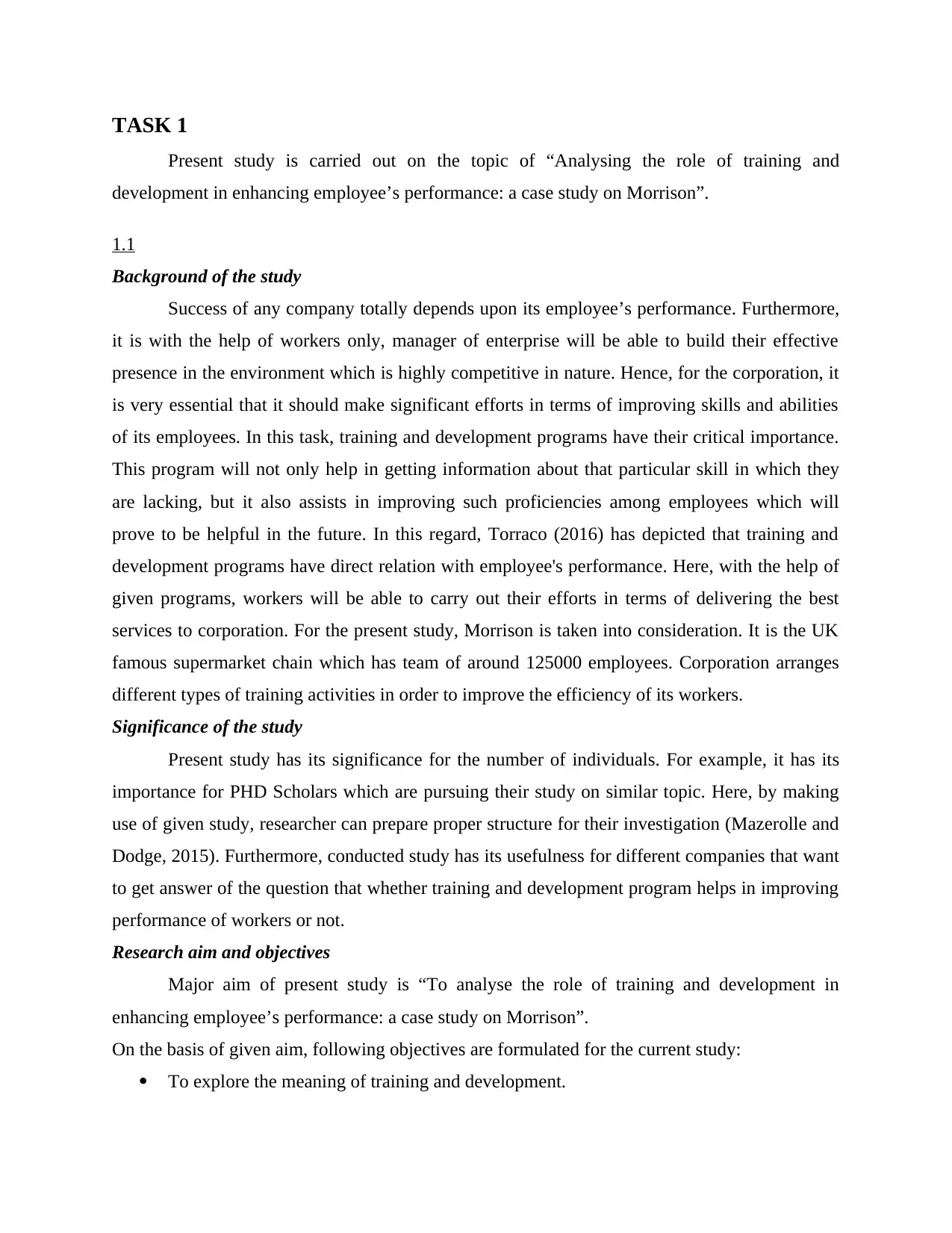
TASK 1
Present study is carried out on the topic of “Analysing the role of training and
development in enhancing employee’s performance: a case study on Morrison”.
1.1
Background of the study
Success of any company totally depends upon its employee’s performance. Furthermore,
it is with the help of workers only, manager of enterprise will be able to build their effective
presence in the environment which is highly competitive in nature. Hence, for the corporation, it
is very essential that it should make significant efforts in terms of improving skills and abilities
of its employees. In this task, training and development programs have their critical importance.
This program will not only help in getting information about that particular skill in which they
are lacking, but it also assists in improving such proficiencies among employees which will
prove to be helpful in the future. In this regard, Torraco (2016) has depicted that training and
development programs have direct relation with employee's performance. Here, with the help of
given programs, workers will be able to carry out their efforts in terms of delivering the best
services to corporation. For the present study, Morrison is taken into consideration. It is the UK
famous supermarket chain which has team of around 125000 employees. Corporation arranges
different types of training activities in order to improve the efficiency of its workers.
Significance of the study
Present study has its significance for the number of individuals. For example, it has its
importance for PHD Scholars which are pursuing their study on similar topic. Here, by making
use of given study, researcher can prepare proper structure for their investigation (Mazerolle and
Dodge, 2015). Furthermore, conducted study has its usefulness for different companies that want
to get answer of the question that whether training and development program helps in improving
performance of workers or not.
Research aim and objectives
Major aim of present study is “To analyse the role of training and development in
enhancing employee’s performance: a case study on Morrison”.
On the basis of given aim, following objectives are formulated for the current study:
To explore the meaning of training and development.
Present study is carried out on the topic of “Analysing the role of training and
development in enhancing employee’s performance: a case study on Morrison”.
1.1
Background of the study
Success of any company totally depends upon its employee’s performance. Furthermore,
it is with the help of workers only, manager of enterprise will be able to build their effective
presence in the environment which is highly competitive in nature. Hence, for the corporation, it
is very essential that it should make significant efforts in terms of improving skills and abilities
of its employees. In this task, training and development programs have their critical importance.
This program will not only help in getting information about that particular skill in which they
are lacking, but it also assists in improving such proficiencies among employees which will
prove to be helpful in the future. In this regard, Torraco (2016) has depicted that training and
development programs have direct relation with employee's performance. Here, with the help of
given programs, workers will be able to carry out their efforts in terms of delivering the best
services to corporation. For the present study, Morrison is taken into consideration. It is the UK
famous supermarket chain which has team of around 125000 employees. Corporation arranges
different types of training activities in order to improve the efficiency of its workers.
Significance of the study
Present study has its significance for the number of individuals. For example, it has its
importance for PHD Scholars which are pursuing their study on similar topic. Here, by making
use of given study, researcher can prepare proper structure for their investigation (Mazerolle and
Dodge, 2015). Furthermore, conducted study has its usefulness for different companies that want
to get answer of the question that whether training and development program helps in improving
performance of workers or not.
Research aim and objectives
Major aim of present study is “To analyse the role of training and development in
enhancing employee’s performance: a case study on Morrison”.
On the basis of given aim, following objectives are formulated for the current study:
To explore the meaning of training and development.
Paraphrase This Document
Need a fresh take? Get an instant paraphrase of this document with our AI Paraphraser
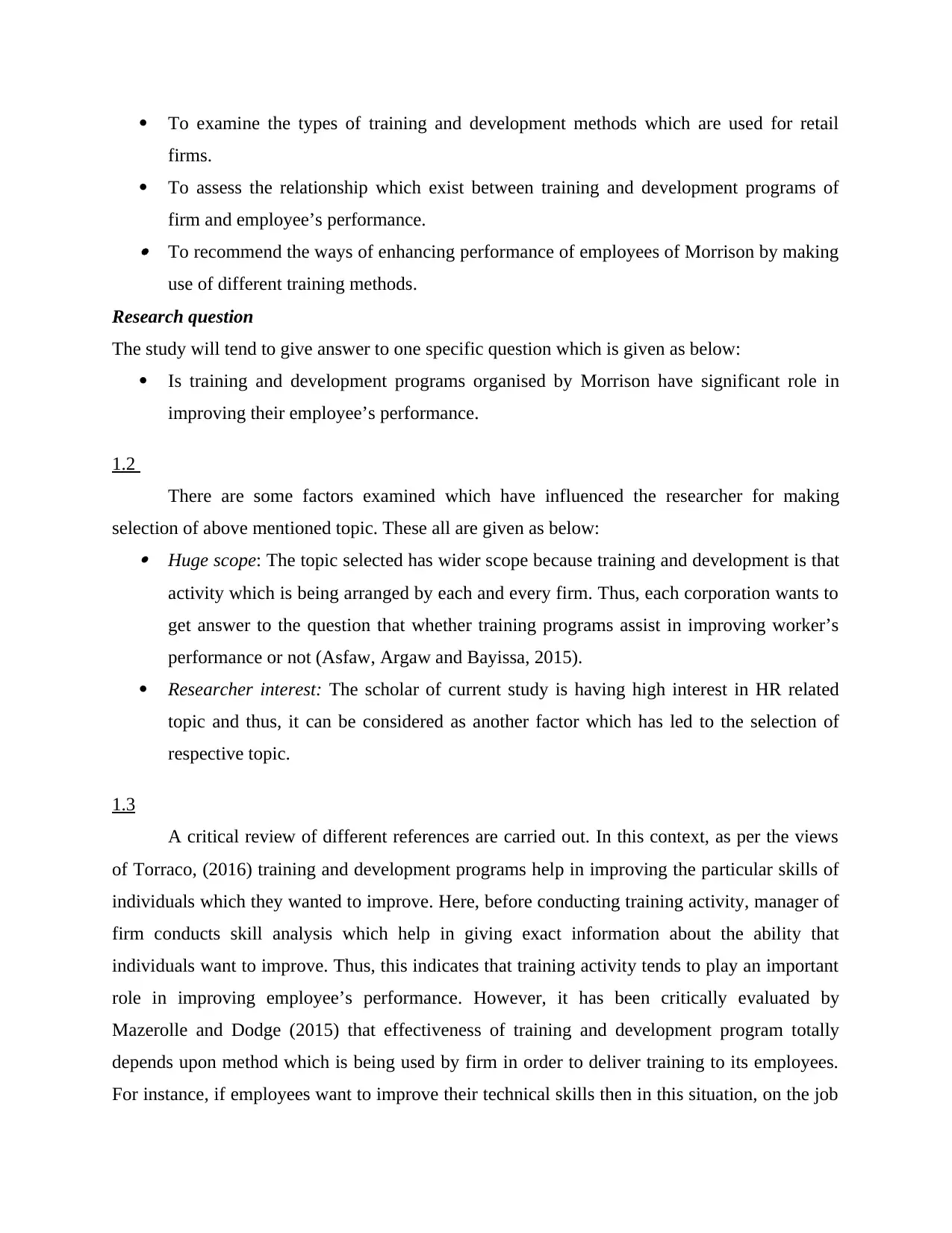
To examine the types of training and development methods which are used for retail
firms.
To assess the relationship which exist between training and development programs of
firm and employee’s performance. To recommend the ways of enhancing performance of employees of Morrison by making
use of different training methods.
Research question
The study will tend to give answer to one specific question which is given as below:
Is training and development programs organised by Morrison have significant role in
improving their employee’s performance.
1.2
There are some factors examined which have influenced the researcher for making
selection of above mentioned topic. These all are given as below: Huge scope: The topic selected has wider scope because training and development is that
activity which is being arranged by each and every firm. Thus, each corporation wants to
get answer to the question that whether training programs assist in improving worker’s
performance or not (Asfaw, Argaw and Bayissa, 2015).
Researcher interest: The scholar of current study is having high interest in HR related
topic and thus, it can be considered as another factor which has led to the selection of
respective topic.
1.3
A critical review of different references are carried out. In this context, as per the views
of Torraco, (2016) training and development programs help in improving the particular skills of
individuals which they wanted to improve. Here, before conducting training activity, manager of
firm conducts skill analysis which help in giving exact information about the ability that
individuals want to improve. Thus, this indicates that training activity tends to play an important
role in improving employee’s performance. However, it has been critically evaluated by
Mazerolle and Dodge (2015) that effectiveness of training and development program totally
depends upon method which is being used by firm in order to deliver training to its employees.
For instance, if employees want to improve their technical skills then in this situation, on the job
firms.
To assess the relationship which exist between training and development programs of
firm and employee’s performance. To recommend the ways of enhancing performance of employees of Morrison by making
use of different training methods.
Research question
The study will tend to give answer to one specific question which is given as below:
Is training and development programs organised by Morrison have significant role in
improving their employee’s performance.
1.2
There are some factors examined which have influenced the researcher for making
selection of above mentioned topic. These all are given as below: Huge scope: The topic selected has wider scope because training and development is that
activity which is being arranged by each and every firm. Thus, each corporation wants to
get answer to the question that whether training programs assist in improving worker’s
performance or not (Asfaw, Argaw and Bayissa, 2015).
Researcher interest: The scholar of current study is having high interest in HR related
topic and thus, it can be considered as another factor which has led to the selection of
respective topic.
1.3
A critical review of different references are carried out. In this context, as per the views
of Torraco, (2016) training and development programs help in improving the particular skills of
individuals which they wanted to improve. Here, before conducting training activity, manager of
firm conducts skill analysis which help in giving exact information about the ability that
individuals want to improve. Thus, this indicates that training activity tends to play an important
role in improving employee’s performance. However, it has been critically evaluated by
Mazerolle and Dodge (2015) that effectiveness of training and development program totally
depends upon method which is being used by firm in order to deliver training to its employees.
For instance, if employees want to improve their technical skills then in this situation, on the job
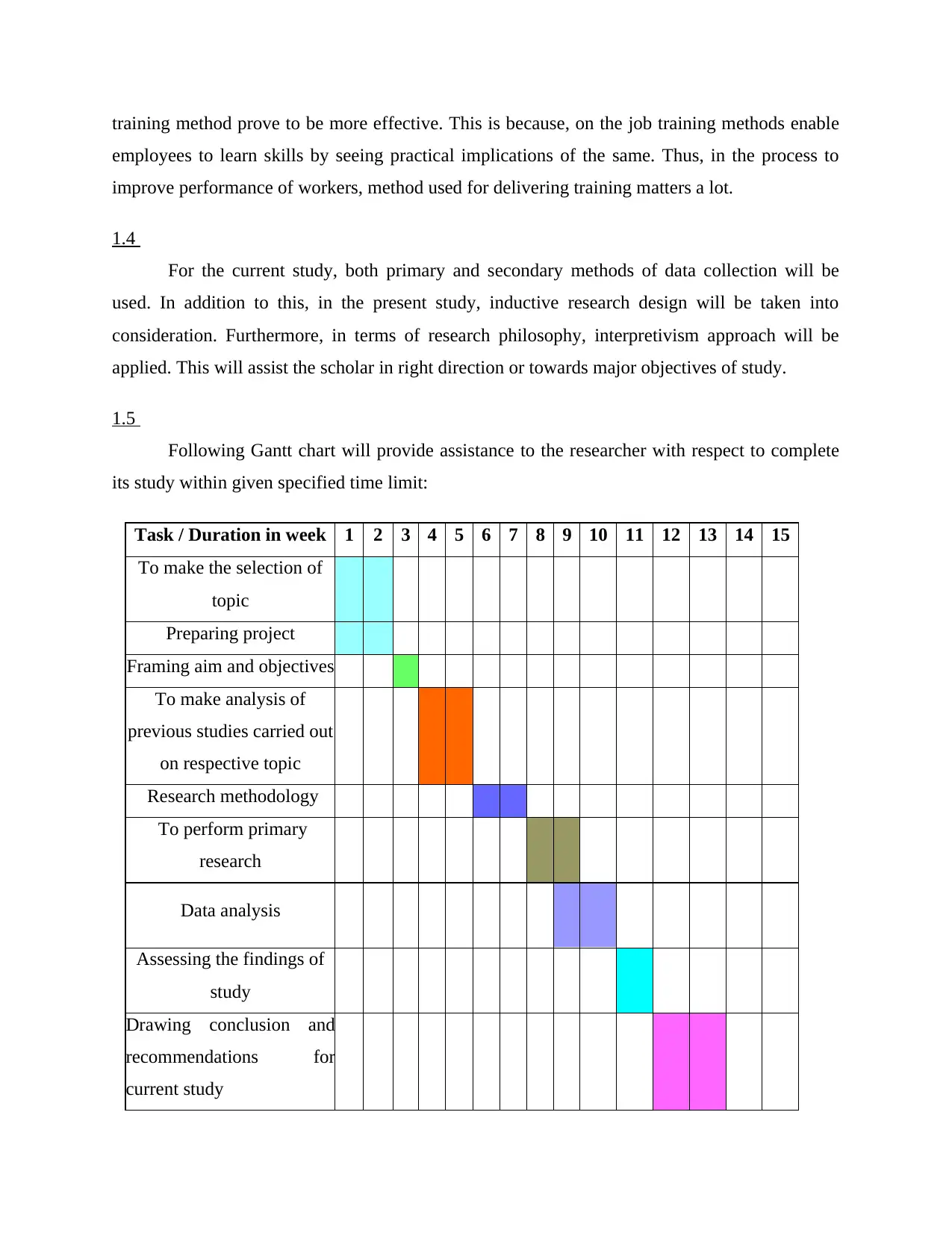
training method prove to be more effective. This is because, on the job training methods enable
employees to learn skills by seeing practical implications of the same. Thus, in the process to
improve performance of workers, method used for delivering training matters a lot.
1.4
For the current study, both primary and secondary methods of data collection will be
used. In addition to this, in the present study, inductive research design will be taken into
consideration. Furthermore, in terms of research philosophy, interpretivism approach will be
applied. This will assist the scholar in right direction or towards major objectives of study.
1.5
Following Gantt chart will provide assistance to the researcher with respect to complete
its study within given specified time limit:
Task / Duration in week 1 2 3 4 5 6 7 8 9 10 11 12 13 14 15
To make the selection of
topic
Preparing project
Framing aim and objectives
To make analysis of
previous studies carried out
on respective topic
Research methodology
To perform primary
research
Data analysis
Assessing the findings of
study
Drawing conclusion and
recommendations for
current study
employees to learn skills by seeing practical implications of the same. Thus, in the process to
improve performance of workers, method used for delivering training matters a lot.
1.4
For the current study, both primary and secondary methods of data collection will be
used. In addition to this, in the present study, inductive research design will be taken into
consideration. Furthermore, in terms of research philosophy, interpretivism approach will be
applied. This will assist the scholar in right direction or towards major objectives of study.
1.5
Following Gantt chart will provide assistance to the researcher with respect to complete
its study within given specified time limit:
Task / Duration in week 1 2 3 4 5 6 7 8 9 10 11 12 13 14 15
To make the selection of
topic
Preparing project
Framing aim and objectives
To make analysis of
previous studies carried out
on respective topic
Research methodology
To perform primary
research
Data analysis
Assessing the findings of
study
Drawing conclusion and
recommendations for
current study
⊘ This is a preview!⊘
Do you want full access?
Subscribe today to unlock all pages.

Trusted by 1+ million students worldwide
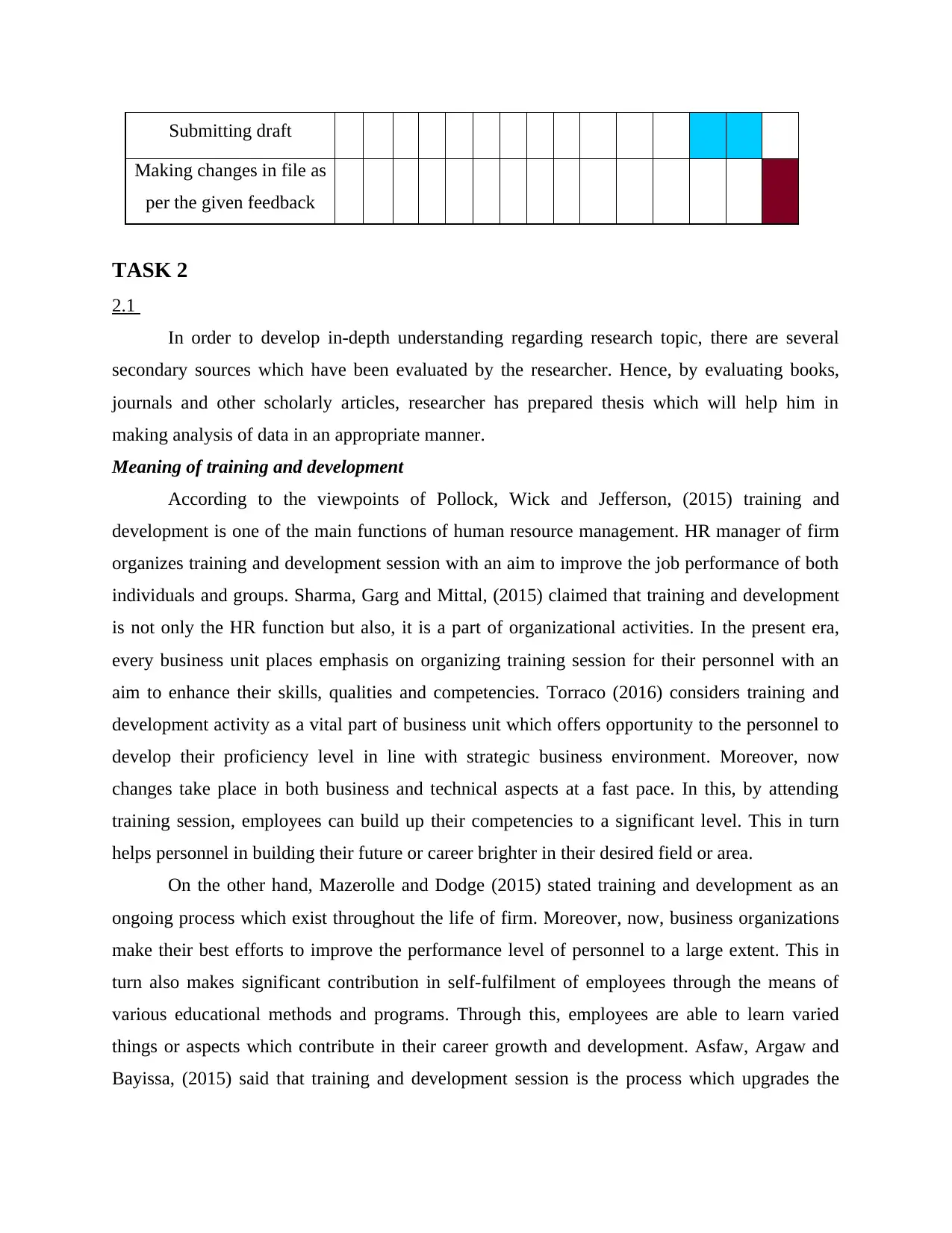
Submitting draft
Making changes in file as
per the given feedback
TASK 2
2.1
In order to develop in-depth understanding regarding research topic, there are several
secondary sources which have been evaluated by the researcher. Hence, by evaluating books,
journals and other scholarly articles, researcher has prepared thesis which will help him in
making analysis of data in an appropriate manner.
Meaning of training and development
According to the viewpoints of Pollock, Wick and Jefferson, (2015) training and
development is one of the main functions of human resource management. HR manager of firm
organizes training and development session with an aim to improve the job performance of both
individuals and groups. Sharma, Garg and Mittal, (2015) claimed that training and development
is not only the HR function but also, it is a part of organizational activities. In the present era,
every business unit places emphasis on organizing training session for their personnel with an
aim to enhance their skills, qualities and competencies. Torraco (2016) considers training and
development activity as a vital part of business unit which offers opportunity to the personnel to
develop their proficiency level in line with strategic business environment. Moreover, now
changes take place in both business and technical aspects at a fast pace. In this, by attending
training session, employees can build up their competencies to a significant level. This in turn
helps personnel in building their future or career brighter in their desired field or area.
On the other hand, Mazerolle and Dodge (2015) stated training and development as an
ongoing process which exist throughout the life of firm. Moreover, now, business organizations
make their best efforts to improve the performance level of personnel to a large extent. This in
turn also makes significant contribution in self-fulfilment of employees through the means of
various educational methods and programs. Through this, employees are able to learn varied
things or aspects which contribute in their career growth and development. Asfaw, Argaw and
Bayissa, (2015) said that training and development session is the process which upgrades the
Making changes in file as
per the given feedback
TASK 2
2.1
In order to develop in-depth understanding regarding research topic, there are several
secondary sources which have been evaluated by the researcher. Hence, by evaluating books,
journals and other scholarly articles, researcher has prepared thesis which will help him in
making analysis of data in an appropriate manner.
Meaning of training and development
According to the viewpoints of Pollock, Wick and Jefferson, (2015) training and
development is one of the main functions of human resource management. HR manager of firm
organizes training and development session with an aim to improve the job performance of both
individuals and groups. Sharma, Garg and Mittal, (2015) claimed that training and development
is not only the HR function but also, it is a part of organizational activities. In the present era,
every business unit places emphasis on organizing training session for their personnel with an
aim to enhance their skills, qualities and competencies. Torraco (2016) considers training and
development activity as a vital part of business unit which offers opportunity to the personnel to
develop their proficiency level in line with strategic business environment. Moreover, now
changes take place in both business and technical aspects at a fast pace. In this, by attending
training session, employees can build up their competencies to a significant level. This in turn
helps personnel in building their future or career brighter in their desired field or area.
On the other hand, Mazerolle and Dodge (2015) stated training and development as an
ongoing process which exist throughout the life of firm. Moreover, now, business organizations
make their best efforts to improve the performance level of personnel to a large extent. This in
turn also makes significant contribution in self-fulfilment of employees through the means of
various educational methods and programs. Through this, employees are able to learn varied
things or aspects which contribute in their career growth and development. Asfaw, Argaw and
Bayissa, (2015) said that training and development session is the process which upgrades the
Paraphrase This Document
Need a fresh take? Get an instant paraphrase of this document with our AI Paraphraser
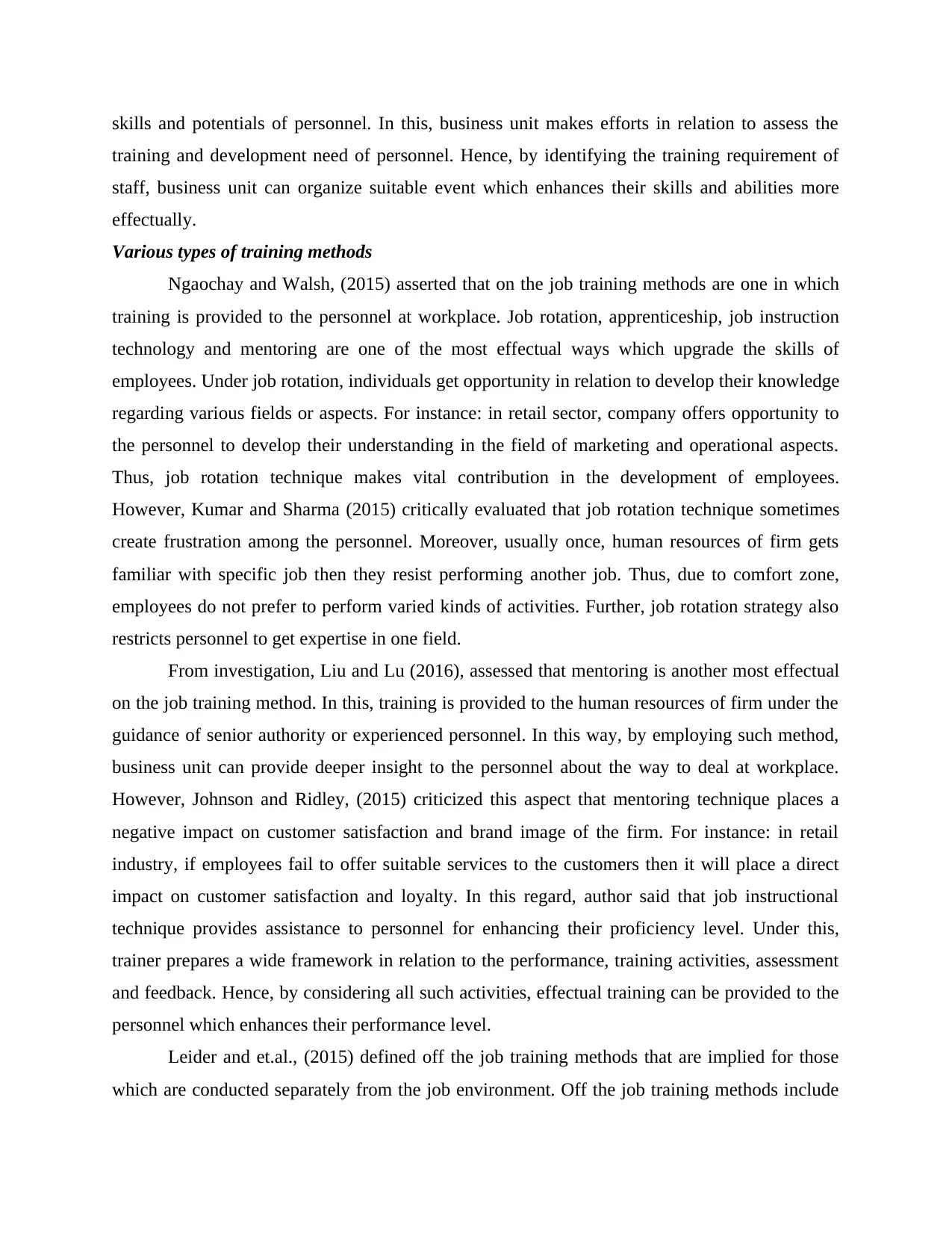
skills and potentials of personnel. In this, business unit makes efforts in relation to assess the
training and development need of personnel. Hence, by identifying the training requirement of
staff, business unit can organize suitable event which enhances their skills and abilities more
effectually.
Various types of training methods
Ngaochay and Walsh, (2015) asserted that on the job training methods are one in which
training is provided to the personnel at workplace. Job rotation, apprenticeship, job instruction
technology and mentoring are one of the most effectual ways which upgrade the skills of
employees. Under job rotation, individuals get opportunity in relation to develop their knowledge
regarding various fields or aspects. For instance: in retail sector, company offers opportunity to
the personnel to develop their understanding in the field of marketing and operational aspects.
Thus, job rotation technique makes vital contribution in the development of employees.
However, Kumar and Sharma (2015) critically evaluated that job rotation technique sometimes
create frustration among the personnel. Moreover, usually once, human resources of firm gets
familiar with specific job then they resist performing another job. Thus, due to comfort zone,
employees do not prefer to perform varied kinds of activities. Further, job rotation strategy also
restricts personnel to get expertise in one field.
From investigation, Liu and Lu (2016), assessed that mentoring is another most effectual
on the job training method. In this, training is provided to the human resources of firm under the
guidance of senior authority or experienced personnel. In this way, by employing such method,
business unit can provide deeper insight to the personnel about the way to deal at workplace.
However, Johnson and Ridley, (2015) criticized this aspect that mentoring technique places a
negative impact on customer satisfaction and brand image of the firm. For instance: in retail
industry, if employees fail to offer suitable services to the customers then it will place a direct
impact on customer satisfaction and loyalty. In this regard, author said that job instructional
technique provides assistance to personnel for enhancing their proficiency level. Under this,
trainer prepares a wide framework in relation to the performance, training activities, assessment
and feedback. Hence, by considering all such activities, effectual training can be provided to the
personnel which enhances their performance level.
Leider and et.al., (2015) defined off the job training methods that are implied for those
which are conducted separately from the job environment. Off the job training methods include
training and development need of personnel. Hence, by identifying the training requirement of
staff, business unit can organize suitable event which enhances their skills and abilities more
effectually.
Various types of training methods
Ngaochay and Walsh, (2015) asserted that on the job training methods are one in which
training is provided to the personnel at workplace. Job rotation, apprenticeship, job instruction
technology and mentoring are one of the most effectual ways which upgrade the skills of
employees. Under job rotation, individuals get opportunity in relation to develop their knowledge
regarding various fields or aspects. For instance: in retail sector, company offers opportunity to
the personnel to develop their understanding in the field of marketing and operational aspects.
Thus, job rotation technique makes vital contribution in the development of employees.
However, Kumar and Sharma (2015) critically evaluated that job rotation technique sometimes
create frustration among the personnel. Moreover, usually once, human resources of firm gets
familiar with specific job then they resist performing another job. Thus, due to comfort zone,
employees do not prefer to perform varied kinds of activities. Further, job rotation strategy also
restricts personnel to get expertise in one field.
From investigation, Liu and Lu (2016), assessed that mentoring is another most effectual
on the job training method. In this, training is provided to the human resources of firm under the
guidance of senior authority or experienced personnel. In this way, by employing such method,
business unit can provide deeper insight to the personnel about the way to deal at workplace.
However, Johnson and Ridley, (2015) criticized this aspect that mentoring technique places a
negative impact on customer satisfaction and brand image of the firm. For instance: in retail
industry, if employees fail to offer suitable services to the customers then it will place a direct
impact on customer satisfaction and loyalty. In this regard, author said that job instructional
technique provides assistance to personnel for enhancing their proficiency level. Under this,
trainer prepares a wide framework in relation to the performance, training activities, assessment
and feedback. Hence, by considering all such activities, effectual training can be provided to the
personnel which enhances their performance level.
Leider and et.al., (2015) defined off the job training methods that are implied for those
which are conducted separately from the job environment. Off the job training methods include
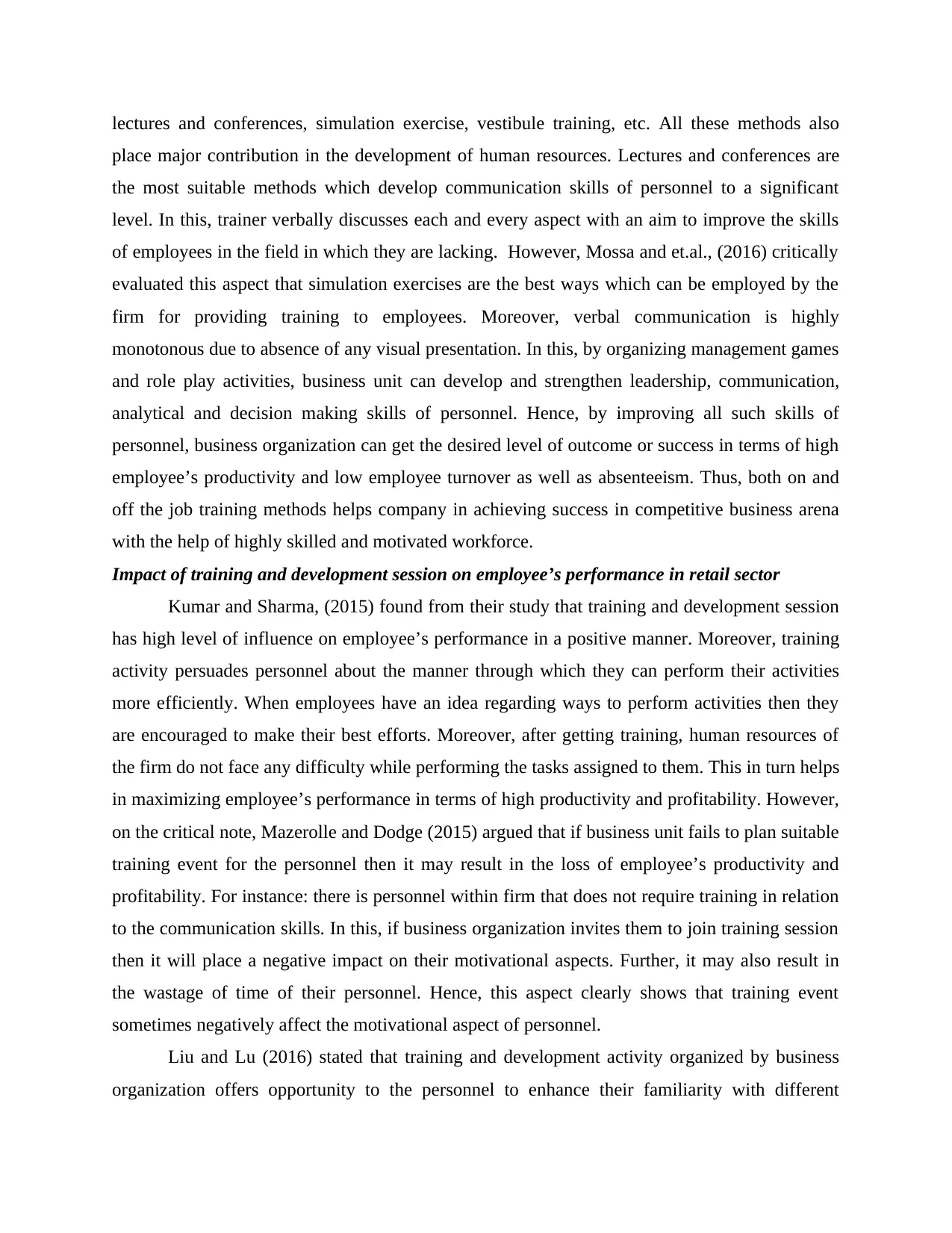
lectures and conferences, simulation exercise, vestibule training, etc. All these methods also
place major contribution in the development of human resources. Lectures and conferences are
the most suitable methods which develop communication skills of personnel to a significant
level. In this, trainer verbally discusses each and every aspect with an aim to improve the skills
of employees in the field in which they are lacking. However, Mossa and et.al., (2016) critically
evaluated this aspect that simulation exercises are the best ways which can be employed by the
firm for providing training to employees. Moreover, verbal communication is highly
monotonous due to absence of any visual presentation. In this, by organizing management games
and role play activities, business unit can develop and strengthen leadership, communication,
analytical and decision making skills of personnel. Hence, by improving all such skills of
personnel, business organization can get the desired level of outcome or success in terms of high
employee’s productivity and low employee turnover as well as absenteeism. Thus, both on and
off the job training methods helps company in achieving success in competitive business arena
with the help of highly skilled and motivated workforce.
Impact of training and development session on employee’s performance in retail sector
Kumar and Sharma, (2015) found from their study that training and development session
has high level of influence on employee’s performance in a positive manner. Moreover, training
activity persuades personnel about the manner through which they can perform their activities
more efficiently. When employees have an idea regarding ways to perform activities then they
are encouraged to make their best efforts. Moreover, after getting training, human resources of
the firm do not face any difficulty while performing the tasks assigned to them. This in turn helps
in maximizing employee’s performance in terms of high productivity and profitability. However,
on the critical note, Mazerolle and Dodge (2015) argued that if business unit fails to plan suitable
training event for the personnel then it may result in the loss of employee’s productivity and
profitability. For instance: there is personnel within firm that does not require training in relation
to the communication skills. In this, if business organization invites them to join training session
then it will place a negative impact on their motivational aspects. Further, it may also result in
the wastage of time of their personnel. Hence, this aspect clearly shows that training event
sometimes negatively affect the motivational aspect of personnel.
Liu and Lu (2016) stated that training and development activity organized by business
organization offers opportunity to the personnel to enhance their familiarity with different
place major contribution in the development of human resources. Lectures and conferences are
the most suitable methods which develop communication skills of personnel to a significant
level. In this, trainer verbally discusses each and every aspect with an aim to improve the skills
of employees in the field in which they are lacking. However, Mossa and et.al., (2016) critically
evaluated this aspect that simulation exercises are the best ways which can be employed by the
firm for providing training to employees. Moreover, verbal communication is highly
monotonous due to absence of any visual presentation. In this, by organizing management games
and role play activities, business unit can develop and strengthen leadership, communication,
analytical and decision making skills of personnel. Hence, by improving all such skills of
personnel, business organization can get the desired level of outcome or success in terms of high
employee’s productivity and low employee turnover as well as absenteeism. Thus, both on and
off the job training methods helps company in achieving success in competitive business arena
with the help of highly skilled and motivated workforce.
Impact of training and development session on employee’s performance in retail sector
Kumar and Sharma, (2015) found from their study that training and development session
has high level of influence on employee’s performance in a positive manner. Moreover, training
activity persuades personnel about the manner through which they can perform their activities
more efficiently. When employees have an idea regarding ways to perform activities then they
are encouraged to make their best efforts. Moreover, after getting training, human resources of
the firm do not face any difficulty while performing the tasks assigned to them. This in turn helps
in maximizing employee’s performance in terms of high productivity and profitability. However,
on the critical note, Mazerolle and Dodge (2015) argued that if business unit fails to plan suitable
training event for the personnel then it may result in the loss of employee’s productivity and
profitability. For instance: there is personnel within firm that does not require training in relation
to the communication skills. In this, if business organization invites them to join training session
then it will place a negative impact on their motivational aspects. Further, it may also result in
the wastage of time of their personnel. Hence, this aspect clearly shows that training event
sometimes negatively affect the motivational aspect of personnel.
Liu and Lu (2016) stated that training and development activity organized by business
organization offers opportunity to the personnel to enhance their familiarity with different
⊘ This is a preview!⊘
Do you want full access?
Subscribe today to unlock all pages.

Trusted by 1+ million students worldwide
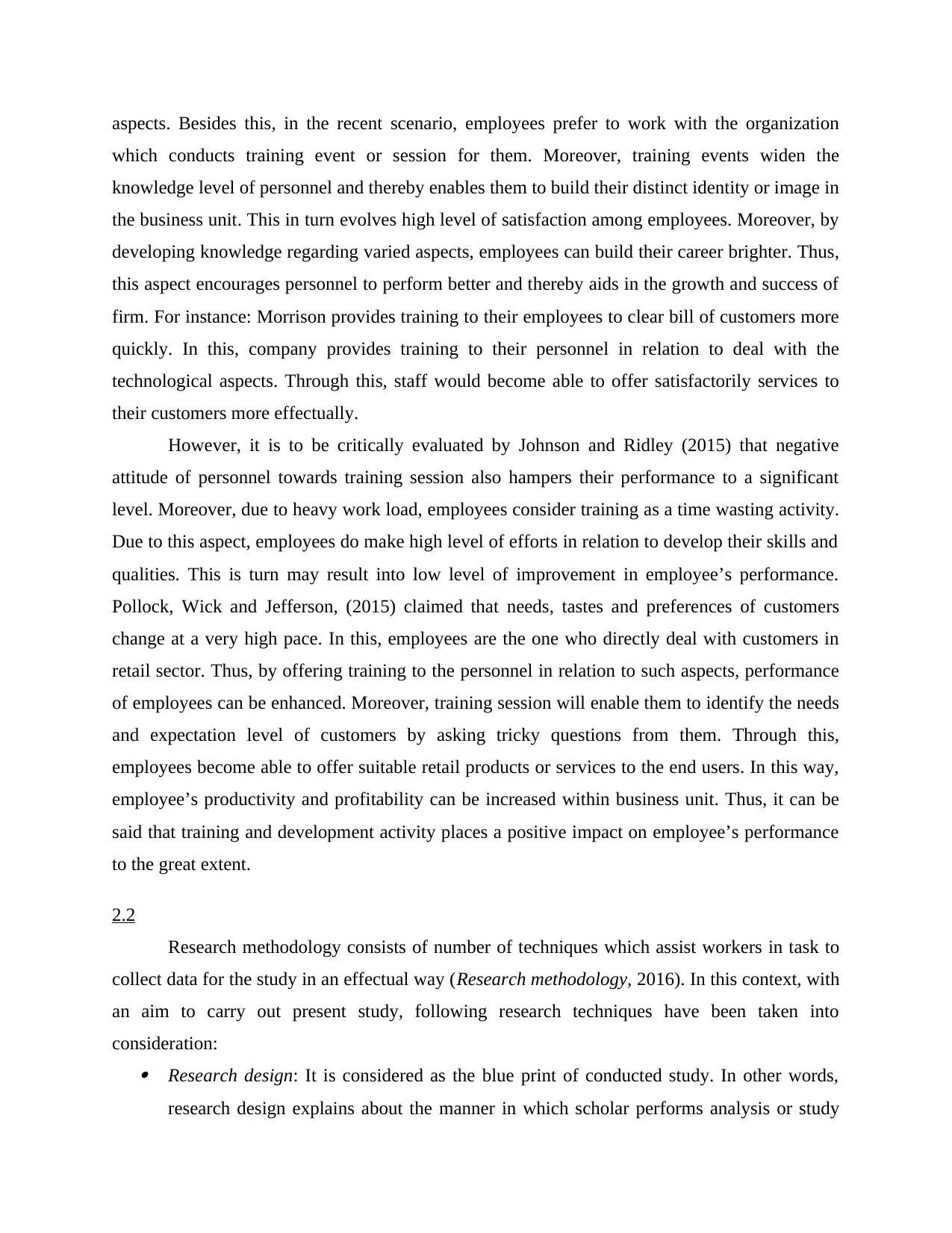
aspects. Besides this, in the recent scenario, employees prefer to work with the organization
which conducts training event or session for them. Moreover, training events widen the
knowledge level of personnel and thereby enables them to build their distinct identity or image in
the business unit. This in turn evolves high level of satisfaction among employees. Moreover, by
developing knowledge regarding varied aspects, employees can build their career brighter. Thus,
this aspect encourages personnel to perform better and thereby aids in the growth and success of
firm. For instance: Morrison provides training to their employees to clear bill of customers more
quickly. In this, company provides training to their personnel in relation to deal with the
technological aspects. Through this, staff would become able to offer satisfactorily services to
their customers more effectually.
However, it is to be critically evaluated by Johnson and Ridley (2015) that negative
attitude of personnel towards training session also hampers their performance to a significant
level. Moreover, due to heavy work load, employees consider training as a time wasting activity.
Due to this aspect, employees do make high level of efforts in relation to develop their skills and
qualities. This is turn may result into low level of improvement in employee’s performance.
Pollock, Wick and Jefferson, (2015) claimed that needs, tastes and preferences of customers
change at a very high pace. In this, employees are the one who directly deal with customers in
retail sector. Thus, by offering training to the personnel in relation to such aspects, performance
of employees can be enhanced. Moreover, training session will enable them to identify the needs
and expectation level of customers by asking tricky questions from them. Through this,
employees become able to offer suitable retail products or services to the end users. In this way,
employee’s productivity and profitability can be increased within business unit. Thus, it can be
said that training and development activity places a positive impact on employee’s performance
to the great extent.
2.2
Research methodology consists of number of techniques which assist workers in task to
collect data for the study in an effectual way (Research methodology, 2016). In this context, with
an aim to carry out present study, following research techniques have been taken into
consideration: Research design: It is considered as the blue print of conducted study. In other words,
research design explains about the manner in which scholar performs analysis or study
which conducts training event or session for them. Moreover, training events widen the
knowledge level of personnel and thereby enables them to build their distinct identity or image in
the business unit. This in turn evolves high level of satisfaction among employees. Moreover, by
developing knowledge regarding varied aspects, employees can build their career brighter. Thus,
this aspect encourages personnel to perform better and thereby aids in the growth and success of
firm. For instance: Morrison provides training to their employees to clear bill of customers more
quickly. In this, company provides training to their personnel in relation to deal with the
technological aspects. Through this, staff would become able to offer satisfactorily services to
their customers more effectually.
However, it is to be critically evaluated by Johnson and Ridley (2015) that negative
attitude of personnel towards training session also hampers their performance to a significant
level. Moreover, due to heavy work load, employees consider training as a time wasting activity.
Due to this aspect, employees do make high level of efforts in relation to develop their skills and
qualities. This is turn may result into low level of improvement in employee’s performance.
Pollock, Wick and Jefferson, (2015) claimed that needs, tastes and preferences of customers
change at a very high pace. In this, employees are the one who directly deal with customers in
retail sector. Thus, by offering training to the personnel in relation to such aspects, performance
of employees can be enhanced. Moreover, training session will enable them to identify the needs
and expectation level of customers by asking tricky questions from them. Through this,
employees become able to offer suitable retail products or services to the end users. In this way,
employee’s productivity and profitability can be increased within business unit. Thus, it can be
said that training and development activity places a positive impact on employee’s performance
to the great extent.
2.2
Research methodology consists of number of techniques which assist workers in task to
collect data for the study in an effectual way (Research methodology, 2016). In this context, with
an aim to carry out present study, following research techniques have been taken into
consideration: Research design: It is considered as the blue print of conducted study. In other words,
research design explains about the manner in which scholar performs analysis or study
Paraphrase This Document
Need a fresh take? Get an instant paraphrase of this document with our AI Paraphraser
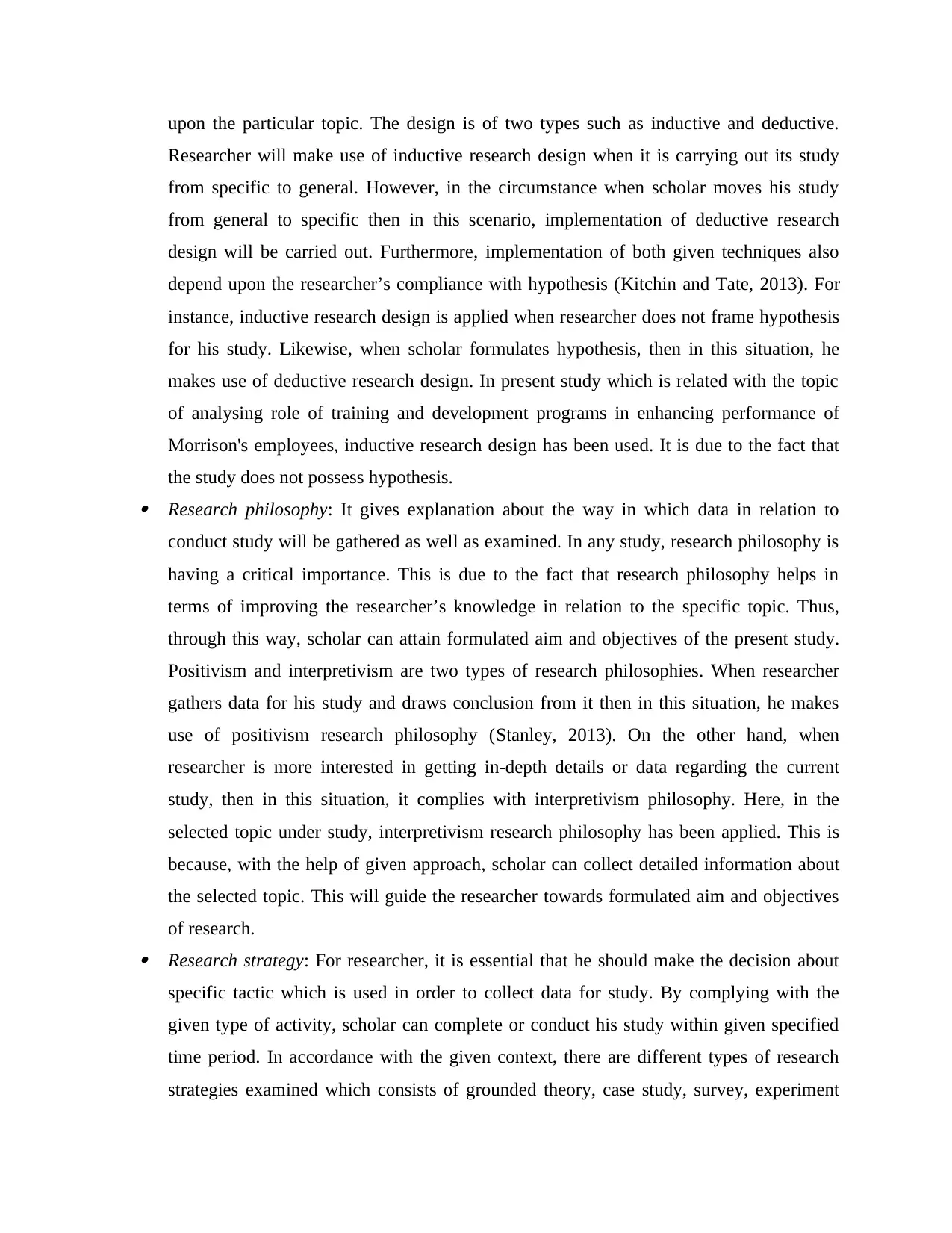
upon the particular topic. The design is of two types such as inductive and deductive.
Researcher will make use of inductive research design when it is carrying out its study
from specific to general. However, in the circumstance when scholar moves his study
from general to specific then in this scenario, implementation of deductive research
design will be carried out. Furthermore, implementation of both given techniques also
depend upon the researcher’s compliance with hypothesis (Kitchin and Tate, 2013). For
instance, inductive research design is applied when researcher does not frame hypothesis
for his study. Likewise, when scholar formulates hypothesis, then in this situation, he
makes use of deductive research design. In present study which is related with the topic
of analysing role of training and development programs in enhancing performance of
Morrison's employees, inductive research design has been used. It is due to the fact that
the study does not possess hypothesis. Research philosophy: It gives explanation about the way in which data in relation to
conduct study will be gathered as well as examined. In any study, research philosophy is
having a critical importance. This is due to the fact that research philosophy helps in
terms of improving the researcher’s knowledge in relation to the specific topic. Thus,
through this way, scholar can attain formulated aim and objectives of the present study.
Positivism and interpretivism are two types of research philosophies. When researcher
gathers data for his study and draws conclusion from it then in this situation, he makes
use of positivism research philosophy (Stanley, 2013). On the other hand, when
researcher is more interested in getting in-depth details or data regarding the current
study, then in this situation, it complies with interpretivism philosophy. Here, in the
selected topic under study, interpretivism research philosophy has been applied. This is
because, with the help of given approach, scholar can collect detailed information about
the selected topic. This will guide the researcher towards formulated aim and objectives
of research. Research strategy: For researcher, it is essential that he should make the decision about
specific tactic which is used in order to collect data for study. By complying with the
given type of activity, scholar can complete or conduct his study within given specified
time period. In accordance with the given context, there are different types of research
strategies examined which consists of grounded theory, case study, survey, experiment
Researcher will make use of inductive research design when it is carrying out its study
from specific to general. However, in the circumstance when scholar moves his study
from general to specific then in this scenario, implementation of deductive research
design will be carried out. Furthermore, implementation of both given techniques also
depend upon the researcher’s compliance with hypothesis (Kitchin and Tate, 2013). For
instance, inductive research design is applied when researcher does not frame hypothesis
for his study. Likewise, when scholar formulates hypothesis, then in this situation, he
makes use of deductive research design. In present study which is related with the topic
of analysing role of training and development programs in enhancing performance of
Morrison's employees, inductive research design has been used. It is due to the fact that
the study does not possess hypothesis. Research philosophy: It gives explanation about the way in which data in relation to
conduct study will be gathered as well as examined. In any study, research philosophy is
having a critical importance. This is due to the fact that research philosophy helps in
terms of improving the researcher’s knowledge in relation to the specific topic. Thus,
through this way, scholar can attain formulated aim and objectives of the present study.
Positivism and interpretivism are two types of research philosophies. When researcher
gathers data for his study and draws conclusion from it then in this situation, he makes
use of positivism research philosophy (Stanley, 2013). On the other hand, when
researcher is more interested in getting in-depth details or data regarding the current
study, then in this situation, it complies with interpretivism philosophy. Here, in the
selected topic under study, interpretivism research philosophy has been applied. This is
because, with the help of given approach, scholar can collect detailed information about
the selected topic. This will guide the researcher towards formulated aim and objectives
of research. Research strategy: For researcher, it is essential that he should make the decision about
specific tactic which is used in order to collect data for study. By complying with the
given type of activity, scholar can complete or conduct his study within given specified
time period. In accordance with the given context, there are different types of research
strategies examined which consists of grounded theory, case study, survey, experiment
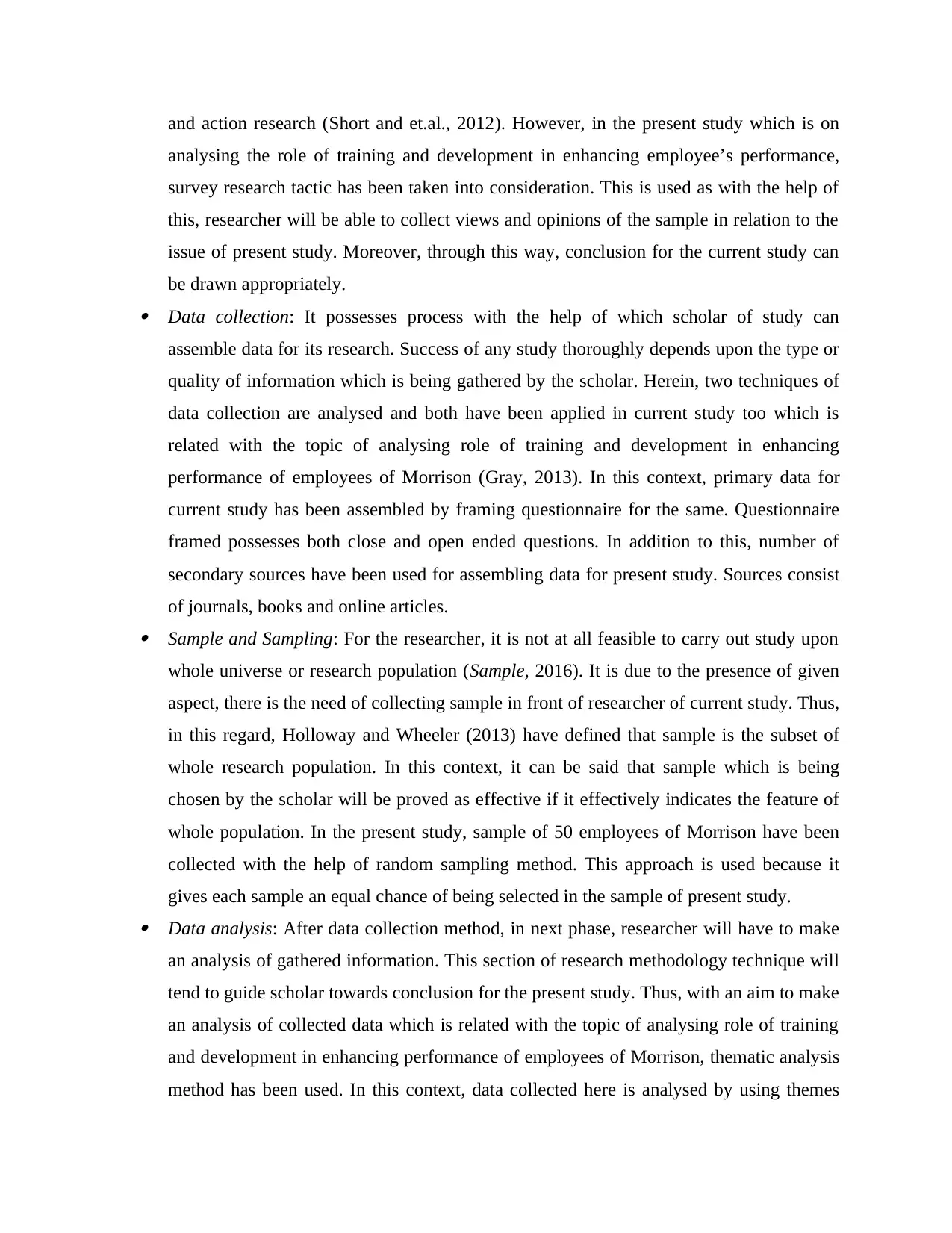
and action research (Short and et.al., 2012). However, in the present study which is on
analysing the role of training and development in enhancing employee’s performance,
survey research tactic has been taken into consideration. This is used as with the help of
this, researcher will be able to collect views and opinions of the sample in relation to the
issue of present study. Moreover, through this way, conclusion for the current study can
be drawn appropriately. Data collection: It possesses process with the help of which scholar of study can
assemble data for its research. Success of any study thoroughly depends upon the type or
quality of information which is being gathered by the scholar. Herein, two techniques of
data collection are analysed and both have been applied in current study too which is
related with the topic of analysing role of training and development in enhancing
performance of employees of Morrison (Gray, 2013). In this context, primary data for
current study has been assembled by framing questionnaire for the same. Questionnaire
framed possesses both close and open ended questions. In addition to this, number of
secondary sources have been used for assembling data for present study. Sources consist
of journals, books and online articles. Sample and Sampling: For the researcher, it is not at all feasible to carry out study upon
whole universe or research population (Sample, 2016). It is due to the presence of given
aspect, there is the need of collecting sample in front of researcher of current study. Thus,
in this regard, Holloway and Wheeler (2013) have defined that sample is the subset of
whole research population. In this context, it can be said that sample which is being
chosen by the scholar will be proved as effective if it effectively indicates the feature of
whole population. In the present study, sample of 50 employees of Morrison have been
collected with the help of random sampling method. This approach is used because it
gives each sample an equal chance of being selected in the sample of present study. Data analysis: After data collection method, in next phase, researcher will have to make
an analysis of gathered information. This section of research methodology technique will
tend to guide scholar towards conclusion for the present study. Thus, with an aim to make
an analysis of collected data which is related with the topic of analysing role of training
and development in enhancing performance of employees of Morrison, thematic analysis
method has been used. In this context, data collected here is analysed by using themes
analysing the role of training and development in enhancing employee’s performance,
survey research tactic has been taken into consideration. This is used as with the help of
this, researcher will be able to collect views and opinions of the sample in relation to the
issue of present study. Moreover, through this way, conclusion for the current study can
be drawn appropriately. Data collection: It possesses process with the help of which scholar of study can
assemble data for its research. Success of any study thoroughly depends upon the type or
quality of information which is being gathered by the scholar. Herein, two techniques of
data collection are analysed and both have been applied in current study too which is
related with the topic of analysing role of training and development in enhancing
performance of employees of Morrison (Gray, 2013). In this context, primary data for
current study has been assembled by framing questionnaire for the same. Questionnaire
framed possesses both close and open ended questions. In addition to this, number of
secondary sources have been used for assembling data for present study. Sources consist
of journals, books and online articles. Sample and Sampling: For the researcher, it is not at all feasible to carry out study upon
whole universe or research population (Sample, 2016). It is due to the presence of given
aspect, there is the need of collecting sample in front of researcher of current study. Thus,
in this regard, Holloway and Wheeler (2013) have defined that sample is the subset of
whole research population. In this context, it can be said that sample which is being
chosen by the scholar will be proved as effective if it effectively indicates the feature of
whole population. In the present study, sample of 50 employees of Morrison have been
collected with the help of random sampling method. This approach is used because it
gives each sample an equal chance of being selected in the sample of present study. Data analysis: After data collection method, in next phase, researcher will have to make
an analysis of gathered information. This section of research methodology technique will
tend to guide scholar towards conclusion for the present study. Thus, with an aim to make
an analysis of collected data which is related with the topic of analysing role of training
and development in enhancing performance of employees of Morrison, thematic analysis
method has been used. In this context, data collected here is analysed by using themes
⊘ This is a preview!⊘
Do you want full access?
Subscribe today to unlock all pages.

Trusted by 1+ million students worldwide
1 out of 24
Related Documents
Your All-in-One AI-Powered Toolkit for Academic Success.
+13062052269
info@desklib.com
Available 24*7 on WhatsApp / Email
![[object Object]](/_next/static/media/star-bottom.7253800d.svg)
Unlock your academic potential
Copyright © 2020–2025 A2Z Services. All Rights Reserved. Developed and managed by ZUCOL.





